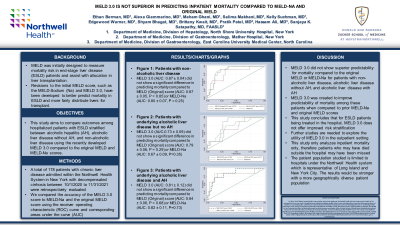Tuesday Poster Session
Category: Liver
P3798 - MELD 3.0 is Not Superior in Predicting Inpatient Mortality Compared to MELD-Na and Original MELD
Tuesday, October 24, 2023
10:30 AM - 4:00 PM PT
Location: Exhibit Hall

Has Audio

Ethan Berman, MD
Northwell Health/Hofstra Zucker School of Medicine
Manhasset, NY
Presenting Author(s)
Ethan Berman, MD1, Alexa Giammarino, MD2, Maham Ghani, MD1, Salima Makhani, MD1, Kelly Suchman, MD1, Edgewood Warner, MD1, Shyam Bhagat, BS3, Brittany Kwait, BS3, Pratik Patel, MD4, Hassam Ali, MD5, Sanjaya Satapathy, MD2
1Northwell Health/Hofstra Zucker School of Medicine, Manhasset, NY; 2North Shore University Hospital/Zucker School of Medicine at Hofstra University, Manhasset, NY; 3Hofstra Zucker School of Medicine, Manhasset, NY; 4Mather Hospital/Hofstra University Zucker School of Medicine, Port Jefferson, NY; 5East Carolina University Medical Center, Greenville, NC
Introduction: The Model for End-Stage Liver Disease (MELD) was initially designed to measure mortality risk in end-stage liver disease (ESLD) patients and assist with liver transplantation. Revisions to the initial MELD score, such as the MELD-Sodium (Na) and MELD 3.0, have been developed to better predict mortality in ESLD This study aims to compare outcomes among hospitalized patients with ESLD stratified between alcoholic hepatitis (AH), alcoholic liver disease without AH, and non-alcoholic liver disease using the recently developed MELD 3.0 compared to the original MELD and MELD-Na scores.
Methods: A total of 178 (males: 129, females: 49) patients with chronic liver disease admitted within the Northwell Health System in New York with decompensated cirrhosis between October 1st, 2020 to November 31st, 2021 were retrospectively evaluated. We compared the accuracy of the MELD 3.0 score to MELD-Na and the original MELD score using the receiver operating characteristic (ROC) curve and corresponding areas under the curve (AUC). We utilized the "rocgold" function to independently test the equality of the ROC area of MELD 3.0 to MELD-Na and the original MELD score. We utilized Statistical software for data science version 16.1 (STATA) for the current analysis.
Results: For patients with non-alcoholic liver disease (n = 50), MELD 3.0 (AUC: 0.87 ± 0.04) did not show a significant difference in predicting mortality compared to MELD (Original) score (AUC: 0.87 ± 0.05, P = 0.85) or MELD-Na (AUC: 0.80 ± 0.07, P = 0.25). In patients with underlying alcoholic liver disease without AH, MELD 3.0 (AUC:0.73 ± 0.09) did not show a significant difference in predicting mortality compared to MELD (Original) score (AUC: 0.79 ± 0.06, P = 0.29) or MELD-Na (AUC: 0.67 ± 0.09, P=0.35). When comparing patients diagnosed with alcoholic liver disease who also had AH on admission (n = 64), MELD 3.0 (AUC: 0.81 ± 0.12) did not show a significant difference in predicting mortality compared to MELD (Original) score (AUC: 0.84 ± 0.06, P = 0.68) or MELD-Na (AUC: 0.82 ± 0.11, P=0.73).
Discussion: MELD 3.0 did not show superior predictability for mortality compared to the original MELD or MELD-Na for patients with non-alcoholic liver disease, alcoholic liver disease without AH, and alcoholic liver disease with AH.

Disclosures:
Ethan Berman, MD1, Alexa Giammarino, MD2, Maham Ghani, MD1, Salima Makhani, MD1, Kelly Suchman, MD1, Edgewood Warner, MD1, Shyam Bhagat, BS3, Brittany Kwait, BS3, Pratik Patel, MD4, Hassam Ali, MD5, Sanjaya Satapathy, MD2. P3798 - MELD 3.0 is Not Superior in Predicting Inpatient Mortality Compared to MELD-Na and Original MELD, ACG 2023 Annual Scientific Meeting Abstracts. Vancouver, BC, Canada: American College of Gastroenterology.
1Northwell Health/Hofstra Zucker School of Medicine, Manhasset, NY; 2North Shore University Hospital/Zucker School of Medicine at Hofstra University, Manhasset, NY; 3Hofstra Zucker School of Medicine, Manhasset, NY; 4Mather Hospital/Hofstra University Zucker School of Medicine, Port Jefferson, NY; 5East Carolina University Medical Center, Greenville, NC
Introduction: The Model for End-Stage Liver Disease (MELD) was initially designed to measure mortality risk in end-stage liver disease (ESLD) patients and assist with liver transplantation. Revisions to the initial MELD score, such as the MELD-Sodium (Na) and MELD 3.0, have been developed to better predict mortality in ESLD This study aims to compare outcomes among hospitalized patients with ESLD stratified between alcoholic hepatitis (AH), alcoholic liver disease without AH, and non-alcoholic liver disease using the recently developed MELD 3.0 compared to the original MELD and MELD-Na scores.
Methods: A total of 178 (males: 129, females: 49) patients with chronic liver disease admitted within the Northwell Health System in New York with decompensated cirrhosis between October 1st, 2020 to November 31st, 2021 were retrospectively evaluated. We compared the accuracy of the MELD 3.0 score to MELD-Na and the original MELD score using the receiver operating characteristic (ROC) curve and corresponding areas under the curve (AUC). We utilized the "rocgold" function to independently test the equality of the ROC area of MELD 3.0 to MELD-Na and the original MELD score. We utilized Statistical software for data science version 16.1 (STATA) for the current analysis.
Results: For patients with non-alcoholic liver disease (n = 50), MELD 3.0 (AUC: 0.87 ± 0.04) did not show a significant difference in predicting mortality compared to MELD (Original) score (AUC: 0.87 ± 0.05, P = 0.85) or MELD-Na (AUC: 0.80 ± 0.07, P = 0.25). In patients with underlying alcoholic liver disease without AH, MELD 3.0 (AUC:0.73 ± 0.09) did not show a significant difference in predicting mortality compared to MELD (Original) score (AUC: 0.79 ± 0.06, P = 0.29) or MELD-Na (AUC: 0.67 ± 0.09, P=0.35). When comparing patients diagnosed with alcoholic liver disease who also had AH on admission (n = 64), MELD 3.0 (AUC: 0.81 ± 0.12) did not show a significant difference in predicting mortality compared to MELD (Original) score (AUC: 0.84 ± 0.06, P = 0.68) or MELD-Na (AUC: 0.82 ± 0.11, P=0.73).
Discussion: MELD 3.0 did not show superior predictability for mortality compared to the original MELD or MELD-Na for patients with non-alcoholic liver disease, alcoholic liver disease without AH, and alcoholic liver disease with AH.

Figure: ROC Curve Tables
Disclosures:
Ethan Berman indicated no relevant financial relationships.
Alexa Giammarino indicated no relevant financial relationships.
Maham Ghani indicated no relevant financial relationships.
Salima Makhani indicated no relevant financial relationships.
Kelly Suchman indicated no relevant financial relationships.
Edgewood Warner indicated no relevant financial relationships.
Shyam Bhagat indicated no relevant financial relationships.
Brittany Kwait indicated no relevant financial relationships.
Pratik Patel indicated no relevant financial relationships.
Hassam Ali indicated no relevant financial relationships.
Sanjaya Satapathy indicated no relevant financial relationships.
Ethan Berman, MD1, Alexa Giammarino, MD2, Maham Ghani, MD1, Salima Makhani, MD1, Kelly Suchman, MD1, Edgewood Warner, MD1, Shyam Bhagat, BS3, Brittany Kwait, BS3, Pratik Patel, MD4, Hassam Ali, MD5, Sanjaya Satapathy, MD2. P3798 - MELD 3.0 is Not Superior in Predicting Inpatient Mortality Compared to MELD-Na and Original MELD, ACG 2023 Annual Scientific Meeting Abstracts. Vancouver, BC, Canada: American College of Gastroenterology.
